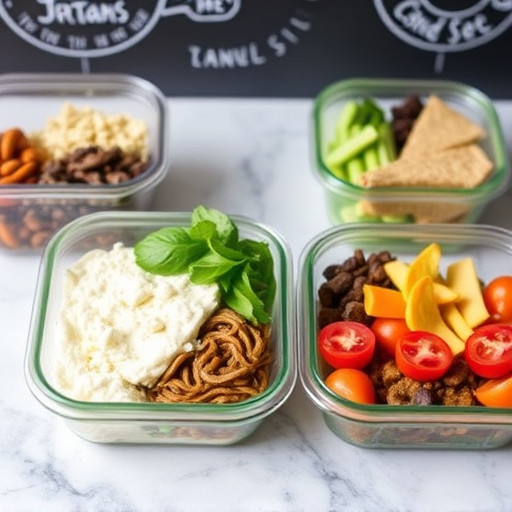Salad meal prep is a healthful, convenient approach for health-conscious individuals. Combining leafy greens, varied vegetables, protein sources, and healthy fats creates balanced salads. Adding diverse ingredients like roasted sweet potatoes or quinoa offers engaging flavor twists. Customizing homemade dressings avoids added sugars. Storing fresh salads in airtight containers in the fridge maintains crispness; consume at room temperature to preserve freshness.
Simple and Healthy Salad Meal Prep Recipes
Salads are an excellent choice for a nutritious, balanced meal, offering a plethora of health benefits when prepared thoughtfully. This article explores the art of creating simple yet delicious salad meals through effective prep techniques. We’ll guide you through choosing essential ingredients to ensure each salad is packed with vitamins, minerals, and fiber. Additionally, we provide creative combinations, healthy dressing suggestions, and practical tips for storing and reheating these refreshing dishes to maintain their freshness and flavor.
- Understanding the Benefits of Salad Meal Prep
- Essential Ingredients for a Balanced Salad
- Creative Salad Combinations and Recipes
- Healthy Dressing Ideas for Extra Flavor
- Storing and Reheating Tips for Fresh Salads
Understanding the Benefits of Salad Meal Prep

Salad meal prep offers numerous benefits for those seeking a simple, healthy, and convenient way to fuel their bodies. By preparing salads in advance, you gain control over your nutritional intake, ensuring each meal is packed with essential vitamins, minerals, and fiber. This method allows for creativity in incorporating a variety of vegetables, fruits, proteins, and grains, making it easy to meet your daily dietary needs.
Moreover, meal prepping saves time during busy weeks. With salads ready to grab and go, you’re less likely to reach for convenience foods or make impulsive, less-than-healthy choices. It promotes mindfulness about eating habits, encourages portion control, and fosters a healthier relationship with food.
Essential Ingredients for a Balanced Salad

When creating a balanced salad, there are key ingredients to include for optimal nutrition and flavor. Leafy greens form the base, offering vitamins A, C, and K, as well as fiber. Examples include spinach, kale, or arugula. Adding a variety of vegetables such as carrots, bell peppers, cucumbers, and tomatoes provides essential nutrients like vitamin C, potassium, and folate. These veggies also add color and texture to keep the salad interesting. For protein, opt for options like grilled chicken, tofu, beans, or nuts, which provide long-lasting energy and help to satisfy hunger. Don’t forget healthy fats from ingredients like avocado, olive oil, or seeds, which aid in nutrient absorption and contribute to a satisfying, well-rounded meal.
Creative Salad Combinations and Recipes

Adding variety to your salads is an excellent way to keep your meal prep interesting and enjoyable. Beyond the classic greens, veggies, and protein mix, creative combinations can transform a simple salad into a delightful culinary experience. For instance, combine roasted sweet potatoes, grilled corn, black beans, and avocado for a vibrant Mexican-inspired dish. Alternatively, try a Mediterranean twist with quinoa, cherry tomatoes, feta cheese, and olives.
Experimenting with different dressings can also elevate your salad game. A simple vinaigrette made from olive oil and balsamic vinegar can be enhanced with herbs like basil or rosemary. For a creamier option, try a yogurt-based dressing mixed with garlic and dill. These creative combinations not only make each meal more exciting but also ensure you get a wide range of nutrients from various food groups.
Healthy Dressing Ideas for Extra Flavor

Healthy dressing is an easy way to elevate your salad from okay to outstanding. Instead of relying on store-bought options high in calories and added sugars, making your own allows for control over ingredients and flavor profiles. A simple vinaigrette—blending olive oil with balsamic vinegar, dijon mustard, salt, and pepper—is a classic choice that provides rich flavor without the excess fat. For a tangy twist, try adding lemon juice or apple cider vinegar.
For those who prefer something creamier, whisk together Greek yogurt, Dijon mustard, minced garlic, fresh herbs like parsley or basil, and a splash of olive oil. You can also experiment with nut butters like peanut or almond butter for added richness and protein. Spices such as cumin, paprika, or chili powder offer unexpected depth while keeping things healthy.
Storing and Reheating Tips for Fresh Salads

Storing fresh salads requires proper container selection and refrigeration to maintain their crispness and vibrant flavors. Use airtight containers designed for meal prep to prevent exposure to air, which can cause oxidation and wilted greens. Before storing, ensure each component of your salad is thoroughly cooled to extend its shelf life. Place the containers in the refrigerator, where temperatures below 40°F (4°C) help preserve freshness.
When it’s time to reheat or enjoy your salad, remove it from the fridge and allow it to sit at room temperature for a few minutes. Avoid over-reheating by keeping the heat low; gently warm ingredients like grains or pasta to maintain texture. For leafy greens, consider using a gentle steam method or adding them directly into a hot soup. Always check ingredient integrity before serving, discarding any items that have changed color or developed off-odors to ensure a fresh and enjoyable meal experience.
Salad meal prep is a simple, versatile, and healthy way to incorporate more greens into your diet. By understanding the benefits, mastering essential ingredients, and exploring creative combinations, you can easily create delicious and nutritious salads that support your well-being. With healthy dressing ideas and practical storage tips, there’s no excuse not to embrace this sustainable and tasty approach to meal preparation.
